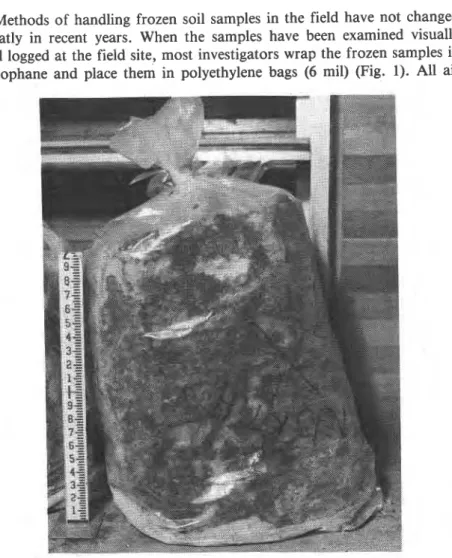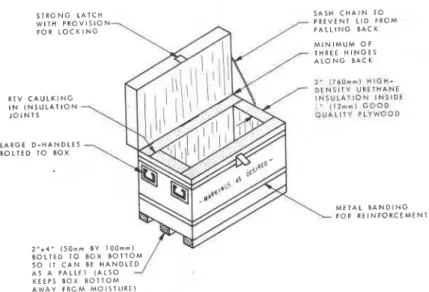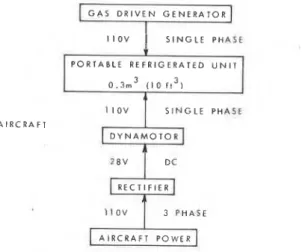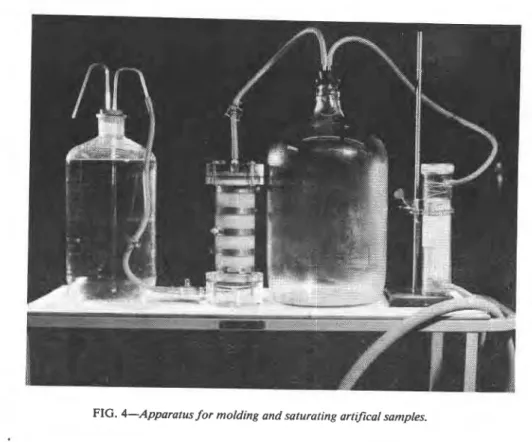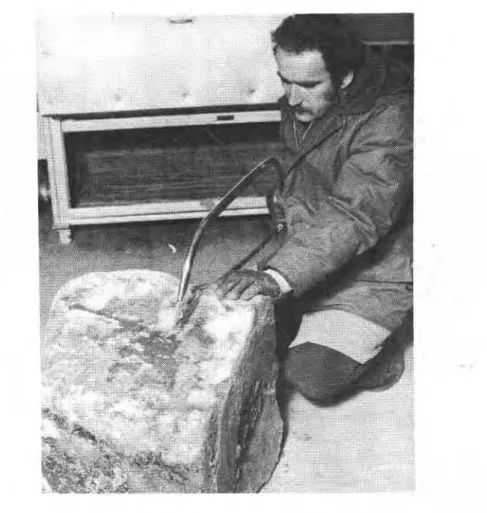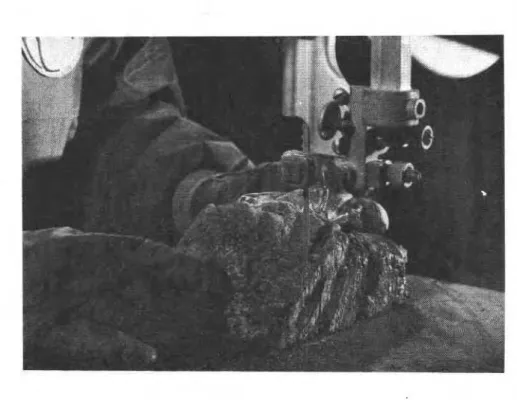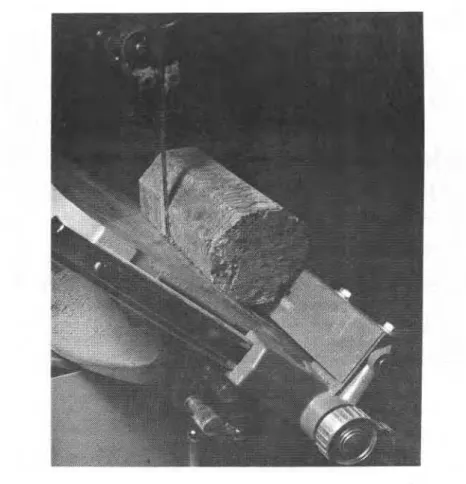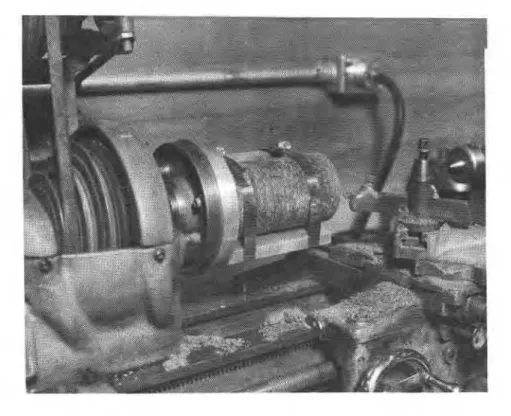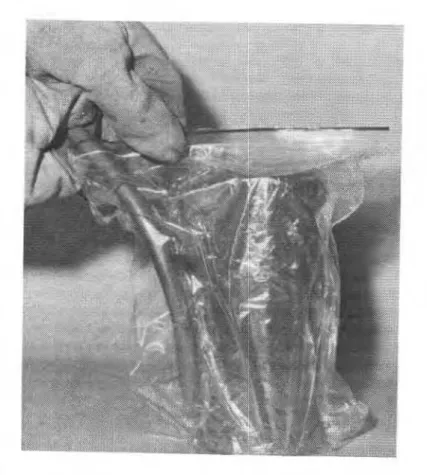Publisher’s version / Version de l'éditeur:
ASTM Special Technical Publication, 599, pp. 88-112, 1976-06
READ THESE TERMS AND CONDITIONS CAREFULLY BEFORE USING THIS WEBSITE.
https://nrc-publications.canada.ca/eng/copyright
Vous avez des questions? Nous pouvons vous aider. Pour communiquer directement avec un auteur, consultez la première page de la revue dans laquelle son article a été publié afin de trouver ses coordonnées. Si vous n’arrivez pas à les repérer, communiquez avec nous à PublicationsArchive-ArchivesPublications@nrc-cnrc.gc.ca.
Questions? Contact the NRC Publications Archive team at
PublicationsArchive-ArchivesPublications@nrc-cnrc.gc.ca. If you wish to email the authors directly, please see the first page of the publication for their contact information.
Archives des publications du CNRC
This publication could be one of several versions: author’s original, accepted manuscript or the publisher’s version. / La version de cette publication peut être l’une des suivantes : la version prépublication de l’auteur, la version acceptée du manuscrit ou la version de l’éditeur.
Access and use of this website and the material on it are subject to the Terms and Conditions set forth at
Transportation, preparation and storage of frozen soil samples for
laboratory testing
Baker, T. H. W.
https://publications-cnrc.canada.ca/fra/droits
L’accès à ce site Web et l’utilisation de son contenu sont assujettis aux conditions présentées dans le site
LISEZ CES CONDITIONS ATTENTIVEMENT AVANT D’UTILISER CE SITE WEB.
NRC Publications Record / Notice d'Archives des publications de CNRC:
https://nrc-publications.canada.ca/eng/view/object/?id=6782fe4d-4041-49f2-a370-a8e23591174c https://publications-cnrc.canada.ca/fra/voir/objet/?id=6782fe4d-4041-49f2-a370-a8e23591174cSer
5343
TH1
,,,,
~ a l
Research Council of Canada
pJ--/
" O *
679
il
national de recherches du Canada
c . 2
BLDG
1
TRANSPORTATION, PREPARATION AND STORAGE OF
FROZEN SOIL SAMPLES FOR LABORATORY TESTING
byT. H.
W.Baker
'/
Reprinted from
ASTM Special Technical Publication
599
June
1976,
25p.
1
_
-
..:----
Ppr'r'<?.CH
I ..
'I
--
\";
2
-
0CT
7
1976
N A T t ~ ~ h ~ RESEARCHcOUNCIL
__C_ Y1
DBR Paper No. 679
60525
Division of Building Research
Price 50 cents
OTTAWA
NRCC 15335SOMMAIRE
L'augmentation des travaux de construction dans les rCgions froides exige
une meilleure connaissance du comportement des sols geles. MalgrC la mise
au point et l'amelioration des mkthodes d'essai
insitu, il est difficile de
proposer des interpretations effectivement utiles puisque les conditions sur
le terrain sont tres variables et complexes. Les essais contrbles en Iaboratoire
sur des sols gel& aident donc 6 determiner les comportements qui reflgtent
differentes conditions sur place et fournissent des donnCes de calcul. Le
present article est un expose de synthPw
4 p -mdthodes employdes et des
difficultes que comportent le t
-, *tion et le stockage des sols
gel& de fason naturelle ou artif
ris de laboratoire. L'auteur
examine Cgalement le probl6ml
Ies sols causC par des varia-
tions de temperature et par la
ie le besoin de poursuivre
Copyright
American Society for Testing and Materials 1916 Race Street, Philadelphia, Pa. 19103
1976
T.
H. W.
Baker'
Transportation, Preparation,
and Storage of Frozen Soil Samples
for Laboratory Testing
ANALYZED
REFERENCE: Baker, T. H. W., "Transportation, Preparation, and Storage of Frozen Soil Samples for Laboratory Testing," Soil Specimen Preparation for Laboratory Testing, ASTM STP 599, American Society for Testing and Materials,
1976, pp. 88-112.
ABSTRACT: Increased wnstruction activities in cold regions require a better understanding of the behavior of frozen soil. Although in sihr testing pro- cedum are k i n g improved or developed, the highly variable and complicated conditicms usually encountered in the field make ir difficult to formulate inter- pretations that are useful in practice. Controlled laboratory tests on frozen soils arc helpful, therefore, in determining behavior indicative of diverse field conditions and will assist in establishing design information. This paper is a review of the procedures used and the difficulties encountered in the transporta- tion, preparation, and storage of naturally and artificially frozen soil samples required for testing in the laboratory. The effective control of sample dis- turbance by temperature variation and sublimation and the need for further in- vestigation as to their effect on the mechanical properties of frozen soil are discussed.
KEY WORDS: soils, frozen soils, transportation, preparation, preserving, sub- limation, thermal degradation, mechanical properties, laboratory tests
Procedures for transporting, preparing, and storing the naturally and artificially frozen soil samples that are required for laboratory testing are still in the formative stages. This paper reviews the cur- rent practices used for naturally frozen field samples from the time of sampling, and for artificially prepared laboratory samples from the start of the molding operation. A review of the literature is included, as well as the experiences of industry, university groups, and government departments and agencies.
'Research officer, Division of Building Research, National Research Council of Canada, Ottawa, Ont., Canada.
Laboratory tests are performed on naturally and artificially pre- pared frozen soil samples to investigate (a) strength and creep de- formation behavior and (b) volume change.
Tests conducted under (a) include: stress and strain controlled un- confined compression tests, stress and strain controlled triaxial shear tests, ring shear tests, Brazilian tests, tension tests, load-controlled indentation tests, flexural strength tests, dynamic loading tests, and torsion tests.
Tests conducted under (b) include: uniaxial consolidation upon thawing under constant stress, triaxial consolidation upon thawing under constant stress, and uniaxial heave during freezing.
The strength and deformation properties of frozen soil samples are known to be affected by sublimation, evaporation, and thermal disturbance. Their effect is in the redistribution and ultimate loss of moisture from the 'specimen
as
the result of a temperature gradient or low humidity environment or both. Loss of moisture reduces the cohesion between soil particles and may reduce the strength (which is dependent on temperature). The effects of moisture redistribution in frozen soil are not known, but are thought to change the strength and creep behavior.Thermal disturbance
of
afrozen
sample refers not only to thawing, but alsoto
temperature fluctuations. SoiI structure may be changed completely if the sampleis
thawed and then refrozen. Temperature fluctuations can set up thermal gradients, causing moisture redis-tribution and possible change in the unfrozen moisture content. Care must be taken, therefore, to ensure that frozen soil specimens remain in their natural or prepared states and that they are protected against the detrimental effects of sublimation and thermal disturbance until testing is completed. The type of laboratory test to be con- ducted will determine the degree of care required in providing this protection.
Frozen Soil Samples Naturally Frozen
Undisturbed block and core samples of frozen soil must be pro- I tected from thawing and loss of moisture, from the time they are
taken from the ground, throughout the period of transportation, storage, machining, and testing. In most cases, the sample must be maintained under the same thermal and moisture conditions existing at the time of sampling. The implications and practicality of this will be discussed later.
Methods of handling frozen soil samples in the field have not changed greatly in recent years. When the samples have been examined visually and logged at the field site, most investigators wrap the frozen samples in cellophane and place them in polyethylene bags (6 mil) (Fig. 1). All air
FIG. I --Large block sample of frozen soil delivered from the feld in a pofjefhyIene bag (scale in tenth. of a foot). .
must be evacuated from the bag, and it must be sealed to prevent sub- limation. This is accomplished best by using a vacuum pump, but can be done by forcing most of the air out by hand before sealing. Humidity can be maintained by placing some snow or crushed ice in the bag. Heat sealing the plastic bag after de-airing gives the most permanent seal, but a locking nylon tie (of the type used for bundling electric cables) is adequate if it is fastened properly. The seal should be checked regularly; any air that has entered the bag should be removed, and the bag should be re- sealed. This packaging procedure keeps moisture loss from the sample within acceptable limits and has been used successfully by the author to
store frozen samples for periods of eight months or more. To minimize still further the moisture loss due to transfer of vapor through the plastic, Roggensack [112 suggested that the wrapped samples should be packed in snow or ice chips. This will reduce vapor pressure gradients. Even with these precautions, some water loss occurs as vapor leaves the sample and crystallizes on the inside of the plastic wrapper. This will be discussed in the section on sublimation.
After the sample has been packaged to keep sublimation to a minimum, some facility is required at the site to prevent thermal disturbance. For example, if unfrozen samples have been obtained for frost heaving experi- ments, they must not be allowed to freeze so that they can be tested in truly undisturbed conditions. If ambient temperatures are below O°C, these samples should be placed in well-insulated boxes and kept in heated tents or some other warm enclosure until they are shipped. On the other hand, when frozen soil samples are obtained for thaw consolidation, strength, and creep tests, the in situ temperature must be maintained. As ground temperatures vary with depth during the year, the temperature should be determined at the time of sampling. In addition, depending on the tests to be conducted, it may be necessary to determine the annual amplitude of the temperature fluctuations at the sample depth.
Maintaining the in situ temperature of the frozen samples has been attempted, using several methods. Portable refrigerators powered by 110-V generators have been used successfully at field sites to store frozen soil samples. These can control adequately the thermal environment and can be set to maintain the temperature measured at the field site when
the sample was obtained. Insulated boxes packed with ice, dry ice, or 1 freezer "jelly" packs have'been used also to prevent thawing of frozen
samples in the field. This is considerably less expensive than the use of
1
! portable refrigerators, but, of course, temperature cannot be controlledaccurately. A typical insulated box used for field storage and shipping
1
by the University of Alberta [ I ] is shown in Fig. 2. When using solidslabs of dry ice, thin sheets (25 mm) of insulation must be placed between the dry ice and the soil samples to minimize "burning" effects caused by contact with carbon dioxide. The dry ice is placed between the insulation and the top, bottom, and sides of the box. If freezer packs are used, they can be arranged in the same manner. A double-walled insulated box has been used, where dry ice is placed in the space between the two walls. The temperatures of samples, packed in this manner, are not constant; they will undergo a fairly rapid drop in temperature, the rate depending on how well protected they are by insulation. The dry ice evaporates slowly, and the temperature of the box (and consequently of the samples) will 'The italic numbers in brackets refer to the list of references appended to this paper.
STRONG LATCH SASH C H A I N TO WITH P R O V I S I O N PREVENT LID FROM F O R L O C K I N G F A L L I N G BACK M I N I M U M O F THREE H I N G E S A L O N G BACK In I 7 4 0 m m ) H I G H - > ? n s r l Y U a t t s A M E RTV C A U L K I N G 1NSULA:IOll INSlOE I N I N S U L A T I O N : - ( l ? r n m ) G O O D J O I N T S o u n l l r Y PLYWOOD LARGE D-HANDLES BOLTED TO BOX METAL B A N D I N G FOR REINFORCEMENT 2 " . 4 ' ' ( 5 0 m m BY l o o m BOLTED TO BOX 8 0 1 1 SO IT C A N BE H A N D 1 AS A PALLET (ALSO
KEEPS BOX BOTTOM AWAY FRCM MOISTURE)
FIG. 2-Typical insulated box used for field storage and shipping.
increase. When ice or freezer packs are used, there is no drastic cooling of the samples, but, in time, the temperature of the insulated box and samples will increase unless the ice is replaced periodically.
If the boxes are to be stored for any length of time (for example, a few weeks), it is advisable to pack snow or crushed ice around the sample bags to prevent sublimation and to fill any air spaces with crushed news- paper to provide added insulation and reduce movement of air in the box. The cover of the box should be fastened securely and made airtight by applying a thin bead of room temperature vulcanizing silicone rubber (RTV) caulking compound around the edge of the lid before the box is closed. '
Although not entirely satisfactory, tempory measures to protect
I samples in the field can be used in some instances. During the winter,
I frozen soil samples, packaged in polyethylene bags, can be buried in snow drifts, or, if the ambient air temperature is below O°C, they can be left in
i
the open air but must be protected (shaded) from the sunlight. During the summer, frozen samples have been stored successfully for up to three days in shallow pits dug in the frozen ground or put into plastic sleeves and stored in the boreholes from which they were taken. The pit should be lined and covered with some insulating material. Moss serves quite well for this purpose. The top of boreholes, used to store samples, should be covered or plugged with insulation to prevent thawing and closing of the hole.If adequate storage facilities are not available at the field site and the samples are to remain frozen, they must be transported immediately to a
temperature- and humidity-controlled storage area. The frozen soil sam- ples must be shipped in refrigerated containers or insulated boxes. Power requirements for shipping a typical refrigerated unit by aircraft are out- lined in Fig. 3 [2]. A competent person should accompany frozen samples
F I E L D S I T E G A S D R I V E N G E N E R A T O R I l l O V ( S I N G L E P H A S E
+
P O R T A B L E R E F R I G E R A T E D U N I T S I N G L E P H A S E A I R C R A F T R E C T I F I E RG
l l O V[
3 P H A S E A I R C R A F T P O W E R FIG. 3-Power for refrigerated units.transported by commercial airlines from the field to the laboratory. (Refrigerated units not attended could be left unplugged on the parking apron or in a storage area, and thawing or undesirable temperature changes of the samples might occur.) Arrangements can be made to have the
insulated boxes placed in airport freezers between flights. Cold storage I areas are not always available, but restaurants and cafeterias at airports
are usually-most helpful in allowing their facilities to be used for this 4 purpose if the containers
are
not too large ortoo many;
arrangements1
for storageen
route should be made prior to shipment. The author has!
found that insulated boxes packed properlycan
be left without auxiliaryfreezing up to 8 or 9
h
without apparent deterioration of the sampIes. The samples can be left in the insulated containers and placed in cold storagej
upon arrivalat
the laboratory until required for testing.Preparing and transporting naturally frozen undisturbed soil samples for laboratory testing is a very difficult and costly operation. In most cases, and for most purposes, insulated boxes have been used successfully to transport frozen samples to the laboratory, provided care has been taken in packaging, storing, and handling the containers.
Artificially Frozen
I
The physical properties that affect the mechanical behavior of soil, for example, homogeneity, grain size, moisture content, compaction, and, to
some extent, ice lens structure, should be closely controlled. This can be achieved in the laboratory by using special molds and controlled methods of freezing.
,
The steps followed in the preparation of laboratory frozen soil speci- mens are:1. Assembly of the mold.
2. Compaction of the soil sample. 3. Saturation of the sample. 4. Freezing. /
5. Disassembly of the mold and removal of the sample.
The geometry of the mold is determined by the desired shape of the test specimen. Rectangular, cylindrical, and dumbbell specimen shapes commonly are used, depending on the test to be performed. As unidirec- tional freezing of the sample is usually desirable, the mold is fabricated from or covered with materials having good insulating properties. Use of split molds with all joints fastened by easily removed connectors greatly facilitates specimen removal after freezing. All interfacing surfaces of the mold and all threads on metal connectors should be coated with a lubri- cant to ensure a tight fit for evacuating the air from the samples and to aid in extracting the sample from the mold in the cold room. Care must be taken to prevent the lubricant (especially the silicone types) from coming in contact with the sample.
Air-dried soil usually is placed into a mold in 30-mm-thick layers and compacted by a drop hammer or vibration action, following standard soil mechanics procedures (for example, Modified Proctor, American Association of State Highway Officials' Standard). Each layer should be scarified to a depth of approximately 5 mm before the next layer is placed. If the soil has a wide range of grain sizes, vibration may cause the particles to separate into layers of uniform size. For sands, the vibratory technique is the better compaction method.
The following method of evacuation and saturation has been found by Haynes [3] to give a fully saturated compact sample.
After the sample has been compacted, caps can be placed on each end of the mold. Both end caps should be fitted with hose connections, which include porous stones, to prevent the loss of soil during the air evacuation and water saturation phase. Plastic tubes are connected to both of the end caps. The tube from the top cap is connected to a vacuum pump; the tube from the bottom cap leads to an on/off valve and then to a reservoir of distilled water. A vacuum pump is also connected to the water reservoir. The on/off valve allows for separate deaeration of the mold and the reservoir. A photograph of the apparatus is shown in Fig. 4.
A vacuum is applied to the top of the mold with the on/off valve closed. At the same time the distilled water reservoir is placed under a
FIG. 4-Apparatus for molding and saturating artifical samples.
vacuum to remove as much air as possible. After about 2 h, the vacuum pressure in the reservoir is decreased, and the valve is opened. A differen- tial pressure between the mold vacuum and the water tank vacuum is
maintained so that the water travels up through the sample and saturates it at
a
slow steady rate. Fast saturation must be avoided to prevent: (a) piping of water through channels along the outside of the sample; (b) a"quick" condition disturbing the dense packing obtained in compaction;
or
{c) incomplete evacuationof
air. When the samples appear to be sat-urated (that is, water can be seen in the top tube), the vacuum pumps are
turned off, and the sample is allowed to saturate under a 0.5-m head of water for about 1 h.
Goughnour and Andersland 141 and N o a h et a1
[a
prepared sand-icespecimens by mixing natural snow uniformly with a selected proportion of
precooled sand. This mixture was compacted in the mold, and water, pre- 1
cooled
to lac, was admitted under pressure. Little snow melted duringthis process, and the sand pzrticles remained dispersed during freezing. 1
Using
this procedure, frozen sand specimens were obtained with large ice Icontents. 1
Vyalov
[a
reported that frozen soil without ice segregation can be ob-specimens having a layered or reticulate structure (that is, horizontal or randomly oriented in layers, respectively), the soil samples should be fro- zen at temperatures of about
-
6°C or above. A layered, ice-lensed struc- ture is obtained by cooling one end of the sample and providing free access to a constant supply of water at the other end.Tsytovich and Sumgin
[A
investigated the influence of the freezing method on the unconfined compressive strength. The results indicated that a freezing temperature between - 12 and-
17°C gave a relatively lower strength if the freezing time was less than three days for sand and four days for clay. They also found that the strength properties were not affected significantly if the freezing occurred from all sides or only from the top down.To achieve a uniform moisture content throughout a sample of Fair- banks silt, Haynes [3] froze specimens unidirectionally in a cold chamber at a temperature of - 37 "C. The bottom mold connection was attached to a water supply; the top of the mold was exposed to freezing temperatures. Loose insulation (granulated cork) was placed under and around the mold to reduce radial heat loss and to allow the sample to freeze from the top down. Vermiculite can be used for this purpose instead of granulated cork (Fig. 5). A constant supply of water was maintained at the bottom of the mold to replenish the water that migrated upward from the unfrozen zone
to the freezing front. Thermistors, placed at locations along the center line of the specimen, recorded the freezing rate.
Cold rooms, refrigerated cabinets, and constant temperature baths have been used by many investigators
to
control the freezing rateof
remolded soils. Many cooling systems haveslow
response times, so that rapid ad- justment of the rateof
heat extraction from the sample is usually very difficult.More accurate control of the freezing process can be obtained, using a thermoelectric cooling plate which operates on the Peltier effect [ 8 ] . The design of a cooling plate (Peltier module) is described in detail elsewhere
[9,10]. The temperature of the plate can be maintained with an accuracy
of at least k0.02"C. As heat removal from the sample is uniaxial, this method is well suited for unidirectional freezing of a soil specimen. Sam- ples of various sizes, with variations in moisture content of zk 1.5 percent by dry weight, have benn frozen succesfully under many different test conditions, using a thermoelectric plate at the Division of Building Re- search (DBR), National Research Council of Canada (NRC) [9].
Rapid sample freezing minimizes redistribution of soil moisture. Freez- ing too rapidly, however, can cause entrapment of air bubbles in the specimen and tensile failures due to thermal shock. Typical freezing rates used by Sayles and Haines [11,12] on small specimens (69 mm diameter by 140
mm
high) were:Ottawa sand (20 to 30
mesh) 38 mm/day
Manchester fine sand 40 mm/day
Hanover silt 80 mm/day
Suffield clay 170 mm/day
Methods of freezing large remolded soil specimens have been reported by Warder and Andersland [13] (125 mm diameter by 300 mm high) and Laba [I41 (100 mm diameter by 241 mm high), but no reference was made to their homogeneity. It is not known whether it is possible to produce
large uniform samples using existing freezing techniques. Samples frozen I in the laboratory are molded normally in the .test apparatus and frozen
just prior to testing, thus eliminating the difficulties associated with the i
storage of frozen specimens. 1
I
Machining and Preparation of Specimens for Testing
1
The machining and preparation procedures used for frozen soils depend upon the size and shape of the specimen required, the type of soil, and the particular test being performed. Similar procedures are followed for cutting and machining both naturally frozen and artificially frozen sam- ples.
Frozen
soil samples should be handled with gloves and all tools and equipment kept in the cold room to avoid sample damage by localized thawing. A temperature of-
5 4 1 "C i s the most suitable ambient tem- perature for machining with respect to material workability and personal comfort. At warmer temperatures, surface thawing is a problem, and cutting tools must be cleaned frequently, for they become coated and clogged with frozen soil, reducing their cutting efficiency. Working at colder temperatures is uncomfortable and slow. The soil is also difficult to work with because of increased hardness; cracks can be formed easily in it, due to increased brittleness.Any cracking induced in the specimen during preparation will reduce the load-carrying capability and influence the test results. Thermal dis- turbance, due to frictional melting by a cutting tool, may be insignificant when preparing specimens for thaw consolidation tests, but it may be very significant for strength tests. Extreme care must be taken when machining frozen soil samples for testing to keep disturbance to an absolute mini- mum.
Various cutting and grinding techniques have been used to machine specimens to the shape required for the test to be performed.
Rough Cutting Methods
A number of methods for cutting frozen soil, including using a hand, band, or chain saw, forcing a cutting edge into the frozen soil, and using a hot wire have been investigated at NRC. Others have found rotary dia- mond saws satisfactory. The advantages and disadvantages of these meth- ods are summarized in Table 1.
Finishing Methods
After being cut roughly to the required dimension, rectangular speci- mens are finished usually by one, or a combination, of the following methods, listed in increasing order of precision:
1. Hand shaving with a sharp, straight cutting edge (for example, a draw knife).
2. A coarse wood rasp or file.
3. Grinding with several grades of emery paper or grinding stone.
1
4. Milling machine equipped with heavy-duty cutters.I 5. Drill press (heavy-duty) equipped with an end milling tool.
These methods have been used on a wide range of frozen soils, and the particular application of each is dependent upon the required specimen tolerances. The allowable specimen tolerance is dependent on the type of test to be preformed and is discussed next.
Cylindrical specimens
are
machined either ona
metal working lathe or cut carefuIly with a coring tube in the laboratory,A lathe is being used extensively at the Division of Building Research to obtain well finished cyIlndrica1 specimens of most types of frozen soils up to 150 mm in diameter. SoiIs containing pebbles are extremcIy difficult to machine on
a
lathe. If pebbles are not pIucked out by the lathe, the speci- men becomesjammed
on the cutting tool and breaks between the tool post and the chuck. The various steps in the preparationof
specimens on a latheare
outlined pictorially in Figs. 8-10.Samples are cut initially to eight-sided cylinders on the bandsaw. A V-bIock is used to hold the specimen so that tbe ends can be squared on the bandsaw. The dimensions of the eight-sided cylinder are chosen so that the specimen can be turned to a right cylinder with both ends faced. A finished specimen 75
mrn
in diameter by 150mm
long is turned froman
eight-sided cyIinder 85rnm
across the end and 200mm
long.The eight-sided cylinder is placed on the lathe, with one end supported in
a
four-jaw chuck and the other end supported by the tailstock. The tailstock is separated from the specimen by theround
wooden block which has sandpaper glued to one side and a cone seat (for the tailstock) on the other. Pressure applied to the specimen by the tailstock is distributed evenly over the face of the specimen by the wooden bIock.Best results are obtained when the frozen soil specimen is turned at 690
rpm
and
the carriage feed setat
30 mrn/36 revolutions. The maximum depth of cut should be Iimited to 0.38mm.
A tungsten carbide cutting tool, with a minimum back clearance of 45 deg, gives the best results. For clean curs, the tool has to be sharpened often, as the abrasive action of the soil duUs the edge quickly.A tool post grinder can be used for dressing coarse-grained soils. Grinding efficiency for fke-grained soils is reduced by buildup o f material on the grindstone. A special holder that screws onto the spindle of the lathe and allows the ends of the specimen to be squared and faced with the cutting tool is shown in Fig. 10.
Cylindrical samples can be cored from block samples in the laboratory, 1 I using a diamond set core barrel and a Iarge industrial drill press. The
block is held to the drill press frame by clamps. This procedure has been 1 used in AIaska to produce sand and grave1 specimens with less than 0.5
percent variation in diameter and for silt and cIay samples with less than 0.4 percent variation
[IA.
The drill press was fitted with a gas swiveI through which pressurized liquid nitrogen vapor was passed t o blow the cuttings away.The
configuration of the diamond matrix and vents on the core bitwas
varied in order to core each type of soil most effectively. To obtain specimens of consistent diameter, the internal diameter of the core bit muss be checked often and the diamond matrix replaced if the allow- able tolerances are exceeded.FIG. 6-Use o f a swede saw for rough cutting large block samples.
At the University of AIberta, a core barrel attached to a milling ma- chine was used to core cyIindrical specimens from block samples [ I ) . An 80 mm length of steel tubing (67 mm inside diameter) was fabricated with a cutting edge on one end. The cutting edge was formed by rolling the lip of the tube inward and sharpening it to an inside diameter of 64 mm. The core barrel, clamped in the drive chuck of a milling machine, was rotated at 300 rpm. Only short specimens were prepared for testing. Long speci- mens break during coring, particularly if the frozen soil has a high ice content.
Dumbbell-shaped specimens for tensile testing are prepared in molds or by machining samples on the lathe, using these procedures.
FIG. 7-Use of band saw to cut smaller somples.
may contain large ice inclusions (lenses, etc.) that are very fragile and easily chipped. Unexpected occurrences of pebbles can ruin many hours of machining if care is not taken when they are detected. Many samples, obtained at high cost in the field, have not been tested because they were too difficult t o machine.
These combined cutting and coring processes are used .to prepare frozen soil specimens for all forms of load testing. Dimensional tolerances for uniaxial thaw-consolidation test specimens are particularly critical, as the sample must fit tightly into the consolidometer ring. The nature of the
other tests is such that the dimensions of specimens are less critical. I I
It is important that the ends of the specimens are parallel and plane, so I
that intimate contact occurs with the loading platens. Seating errors have
been observed on many loading curves 141. Eccentric loading can give
lower strength values [3], but these are often ignored.
4
Although the effects of thermal disturbance induced by machining pro-
cedures have not been investigated, every effort should be made to elimi- I 1
nate or reduce them, especially on clay samples. Surface thawing has been noticed on several occasions when machining specimens of frozen clay.
FIG. 8-Eight-sided cylinder cut on band saw.
Storage and Protection During Laboratory Testing
Careful control of temperature and humidity in storage areas is necessary t o protect the frozen sample from sublimation and thermal disturbance, from the time it has been molded or machined or both until testing has been completed. Protection methods are similar to those used when trans- porting frozen samples from the field. Samples should be wrapped in an impermeable material and stored in a refrigerated room or freezer. Khomichevskaya, one of the earlier Russian investigators, wrapped naturally frozen samples in insulation and stored them in underground rooms for up to seven days with good results [la.
Sublimation of samples can be minimized by controlling the humidity and reducing air flow around the specimen. Most small capacity freezers do not have air circulation fans in the freezing compartments, and air
FIG. 9-Specimen turned on lathe to required diameter.
flow is limited to that caused by convection currents. Large walk-in freezers rely on fans to circulate the air and control the temperature effectively throughout the storage chamber. Frozen samples can be protected from these air currents by wrapping them in cellophane and placing them in plastic bags. Snow or ice shavings can be placed in the bags to raise the humidity around the sample. The bags should then be evacuated t o re- move as much air as possible and heat sealed. These procedures are shown in Figs. 11 and 12.
In studies of ways to store and preserve frozen samples, Livingston
[I71
found that samples lost considerable weight, due to surface evaporation,
when the storage temperature ranged from 0 to -6OC. To study the effect
of the storage temperature on surface evaporation and sublimation, small specimens of frozen Keweenaw silt (approximately 25 mm cubes with polished surfaces) were prepared and stored at various temperatures. The
results indicated that storage at temperatures between - 8 and - 12°C re-
duced the rate of surface evaporation to an acceptable value. Various methods were investigated to reduce sublimation further, as failure to control this moisture loss affects test results. Synthetic resins, silicone oil, varnishes, natural oils, and other commercially available products were
FIG. 10-Facing specimen ends on the lathe using special holder.
eral waxes could not be used as they must be heated. Although many of the surface coatings reduced the rate of surface evaporation, none of the materials investigated provided satisfactory protection for more than one week.
Frozen soil specimens at the University of Alberta have been coated with a thin layer of ice by applying a fine spray of supercooled distilled water [I]. This film of ice prevents sublimation of the sample and is re- moved easily prior to testing.
Yershov et al [I81 published information on the sublimation of frozen soils. As shown in Fig. 13, different soil types have different sublimation rates. Finer grained clay soils have a higher evaporation rate than do coarser sands. The rate of sublimation is affected greatly by the ambient temperature (Fig. 14). The parameters studied were temperature, relative humidity, and air velocity, but no details were given on how the experi- ments were undertaken nor on the apparatus used.
A similar study was undertaken by the author to determine the rate of sublimation on three soil types: Ottawa sand (20 to 30 mesh), Niagara silt, and Leda clay. Four specimens of each soil type were prepared by adding 50 g of water to equal volumes of each soil and placing the mixture in
FIG. 1 I-Evacuating plastic bag to prevent sublimation.
plastic boxes 1.9
x
m deep, having a surface area of 3.31x
m2.Two samples of each soil type had their surfaces covered with cellophane; the others were left uncovered. All the samples were weighed and placed
in the cold room to freeze at a temperature of -4.4"C and a relative hu-
midity of 37 percent. The specimens were weighed after 8 h and then once
a day for 23 days. Results are presented in Fig. 15.
The sublimation rates of the frozen soils investigated by the author are within the same range as those reported by Yershov et a1 [18]. Similarly, it was found that the finer clay soils have higher sublimation rates than the coarser sands. This is because the larger particle surface area in fine-grained soils allows for film flow, which brings the water to the surface of the sample. Samples that were covered with cellophane had significantly lower sublimation rates than those that were left uncovered.
Many investigators [5,7,17,19-211 have found that the compressive strength of frozen soil is greatly dependent on its overall moisture con- tent. Compressive strength increased with increasing moisture content. It
FIG. 12-Heat sealing the plastic bag.
reached a maximum when the soil was saturated completely and then de- creased to the strength of ice. Any loss of moisture from a specimen, therefore, will cause a change in its compressive strength.
The compressive behavior of frozen soil is also affected greatly by tem- perature and by temperature fluctuations. It is imperative, therefore, that specimens be stored and tested in a freezing chamber that has only a small temperature fluctuation to minimize thermal disturbance. The effect of fluctuations in temperature can be reduced by enclosing the specimen in
an insulating jacket during storage and testing. Vyalov
[a
suggested the following permissible temperature variations when storing and testing frozen soils within different ranges:Temperature, OC up to
-
2-
2 to-
5-
5 to-
10 below-
10Permissible devia- +O. 1 &0.2 +0.5 k1.0
tion
Guarded hot plate experiments carried out by Hoekstra [22] using Fair- banks silt (see Fig. 16) show that any thermal gradient in the sample, even at temperatures below freezing, will cause moisture redistribution in fro-
I
T E M P . : - 4 . 4 d e g C R E L . H U M . : 3790 O N E S I D E E X P O S E D C E t L O P H A N E C O V E R E D ( A L L T H R E E S O I L S ) 0
-
I I II
0 100 200 300 4 0 0 5 0 0 6 0 0 700 T I M E , hFIG. 15-Sublimation in NRCIDBR cold room.
0 . 3 5 I I I I I I I I I I I I 1 , I C E L A Y E R
-
I-
-
I N I T I A L W A T E R C O N T E N T-
-
0 I 2 3 4 5 b D I S T A N C E F R O M C O L D P L A T E , i n c h e sFIG. 16-Wfect of temperature gradient on moisture redistribution in frozen Fairbanks
Zen soil. This moisture movement will increase the sublimation/evapora- tion rate, as well as change the fabric of the specimen.
Many investigators [19,23] have found that the unfrozen moisture con- tent will influence greatly the compressive strength of frozen soils. Wil- liams [24], using calorimetric methods, found that there was a hysteresis effect in the temperature dependence of the unfrozen water content. The unfrozen water content of a frozen soil, at a given temperature, is depend- ent on whether the temperature is reached by cooling or warming. If temperature fluctuations occur, even though the specimen remains below O°C, the unfrozen moisture content will change. This is of great concern
when testing frozen soils at temperatures above
-
5 "C.The cold rooms at DBR/NRC provide good examples of well controlled environments. The temperature of the cold rooms can be controlled
accurately by a reheat system to within ~ 0 . 1 "C at any location in the
room. Each refrigeration unit is operated by a two-stage compressor with a capacity of 3.5 tons of refrigeration circulating Freon 22. The cooling capacity is adjusted automatically to be in excess of that required, and the temperature is controlled by electric reheating. The reheat unit has a capacity of 12 kW and is operated by a solid state controller. Two evap- oration units are located in each of the cold rooms so that one unit can be
defrosted without shutting the cold rooms down. A separate auxiliary
compressor and control system is available in case one of the main sys-
tems becomes inoperative. In addition, a freezer of 1 m3 capacity is avail-
able also in the laboratory as a backup system. Samples can be transferred to the freezer in case of emergency shutdown. The need for an alarm sys- tem to provide warning of equipment failure and for several backup sys- tems is appreciated only after samples are lost due to thawing because of unexpected equipment breakdowns.
Conclusions
The important factors to be considered in transporting, preparing, and storing frozen soils for laboratory testing are the control of the effects of sublimation/evaporation and minimization of thermal disturbance. Their effect on the ice content, fabric, and unfrozen moisture content of the specimen, and, therefore, on the strength and deformation behavior of the material, is of great significance. Further evaluation of existing proce- dures and development of new or improved techniques are required be- fore standard methods can be proposed for the laboratory testing of fro- zen soils.
Acknowledgments
The author wishes to acknowledge the assistance of W. D. Roggensack,
A. Slusarchuk, Northern Engineering Services Ltd. (formerly of the Divi- sion of Building Research) in the development of this reveiw paper. References
[I] Roggensack, W. D., University of Alberta, personal communication, 1974.
[2] Slusarchuk, W. A., Northern Engineering Services Ltd., Calgary, Alta., personal com- munication, 1974.
[3] Haynes, F. D., U.S. Army Cold Regions Research and Engineering Laboratory, personal communication, 1974.
[4] Goughnour, R. and Andersland, 0. B., Journal of the Soil Mechanics and Foundation
Division, American Society of Civil Engineers, Vol. 94, No. SMI, 1968, pp. 923-950.
[5] Hooke, R. L., Dahlin, B. B., and Kauper, M. T., Journal of Glaciology, Vol. 11, 1972,
pp. 327-336.
[4
Vyalov, S. S., "Methods of Determining Creep. Long-Term Strength, and Compres-sibility Characteristics of Frozen Soils." National Research Council Technical Transla- tion, TT-1364, Ottawa, 1%9.
[7l Tsytovich, N. A. and Sumgin, M. I. "Principles of Mechanics of Frozen Ground," U.S. Army, Snow, Ice, Permafrost Research Establishment, Translation No. 19, 1959.
[8] Lechner, W., "Peltier Cooling," Philips Technical Review, No. 27, 1966, pp. 113-130.
[9] Williams, P. J., Canadian Geotechnical Journal, Vol. 5, No. 4, 1968, pp. 264-266.
[lo] Webb, E. L. R., "Equivalent Circuit Model for Thermoelectric Temperature Con-
trollers," Bulletin No. 18, Radio and Electrical Engineering Division, National Research Council of Canada, Ottawa, 1968.
[Ill Sayles, F. H., "Creep of Frozen Sands," U.S. Army, Cold Regions Research and Engineering Laboratory, Technical Report No. 190, 1968.
[12] Sayles, F. H. and Haines, D., "Creep of Frozen Silt and Clay," U.S. Army, Cold Re- gions Research and Engineering Laboratory, Technical Report No. 252, 1974.
[13] Warder, D. L. and Andersland, 0. B., Canadian Geotechnical Journal, Vol. 8, No. 1,
1971, pp. 46-68.
[14] Laba, J. T., Highwy Research Record, No. 360, 1971, pp. 26-36.
[I51 Shuster, J. A. in Proceedings of the Symposium on Cold Regions Engineering, Ameri-
can Society of Civil Engineering, University of Alaska, Vol. 1, 1971, pp. 73-117. [ l a Khomichevskaya, L. S., "Compressive Strength of Permafrost and Ice in Their Natural
States," U.S. Army, Arctic construction i d Frost Effects Laboratory, Translation No. 20, 1951.
[17] Livingston, C. W., "Explosion Tests in Keweenaw Silt," U.S. Army, Snow, Ice, Permafrost Research Establishment, Report No. 30, 1956, pp. 25-40.
[18] Yershov, E. D., Gurov, V. V., and Dostovalov, B. N., "Ice Sublimation in Fie-Grained
Soil of Various Cryogenic Structure During its Interaction with an Air-Current," U.S. Army, Cold Regions Research and Engineering Laboratory, Translation No. 439, 1973,
pp
.
247-25 1.[I91 Yong, R. N. in Proceedings of the Permafrost International Conference, National
Academy of Sciences-National Research Council. 1963. pp. 315-319.
[2q Kaplar, C. W., "Some Strength Properties of Frozen Soil and Effect of Loading Rate,"
U.S. Army, Cold Regions Research and Engineering Laboratory, Special Report No. 159, 1971.
[21] Andersland, 0. B., The Norfhern Engineer, Vol. 3, No. 3, 1971, pp. 4-6.
[22] Hoekstra, P., Water Resources Research, Vol. 2, No. 2, 1966, pp. 241-250.
[23] Sanger, F. J., "Foundations of Structures in Cold Regions," U.S. Army, Cold Regions
Research and Engineering Laboratory, Monograph No. III-C4, 1969.
[24] Williams. P. J. in Proceedings of the Permqfrost International Conference, National
